Bodywork paint spray gun
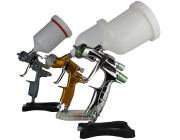
HVLP and low-pressure bodywork paint spray gun
-
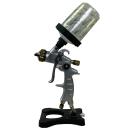 93200Paint gun for baseNozzle 1.3 HVLP + bucket
93200Paint gun for baseNozzle 1.3 HVLP + bucket -
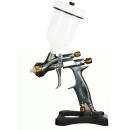 93300Premium paint spray gun for basesNozzle 1.2 HVLP + bucket
93300Premium paint spray gun for basesNozzle 1.2 HVLP + bucket -
 93302Premium paint spray gun for basesNozzle 1.3 HVLP + bucket
93302Premium paint spray gun for basesNozzle 1.3 HVLP + bucket -
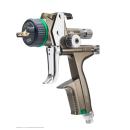 1061887Satajet x 5500 Hvlp Standard1.3mm Nozzle - RPS Buckets
1061887Satajet x 5500 Hvlp Standard1.3mm Nozzle - RPS Buckets -
 1061902Satajet x 5500 Hvlp Standard1.2mm Nozzle - RPS Buckets
1061902Satajet x 5500 Hvlp Standard1.2mm Nozzle - RPS Buckets -
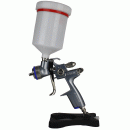 146969Satajet 100 B F RPNozzle 1.4 - QCC PVC bucket
146969Satajet 100 B F RPNozzle 1.4 - QCC PVC bucket -
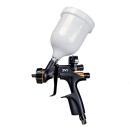 DV1-C-000-13-BDV1 Base1.3mm Nozzle - With rigid cup
DV1-C-000-13-BDV1 Base1.3mm Nozzle - With rigid cup -
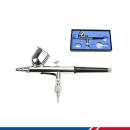 AEROCARAirbrushNozzle 0.3mm
AEROCARAirbrushNozzle 0.3mm -
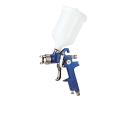 HVLP1.3Hvlp paint gun1.3mm Nozzle
HVLP1.3Hvlp paint gun1.3mm Nozzle
︾
Description and characteristics of paint spray guns for bodywork :
Bodyworkprimer, base and Clearcoat spray guns are essential tools in the automotive paint industry. These guns are used to apply different types of coating such as primers, Basecoats (coloured paints) and Clearcoats. The technical characteristics of these guns can vary depending on the make, model and specific application, but here are some general characteristics to consider:
Paint gun type:
Gravity spray gun :
The cup is located above the Nozzle, allowing for a finer spray and more precise operation.
Suction gun :
The cup is positioned below the Nozzle, which is convenient for large areas but can result in a slightly less fine spray.
Air pressure:
Most body spray guns operate with compressed air pressure. The recommended air pressure may vary depending on the type of coating being sprayed. Some guns offer pressure settings to suit different applications.
Nozzle and needle :
The size of the Nozzle and Needle is crucial to achieving the correct particle size when spraying. Nozzles of different sizes are often included to suit different types of coating.
Air flow and paint volume :
Body spray guns often have settings to control airflow and paint volume. These adjustments are essential to achieve the correct spray density and desired coverage.
Materials of construction:
Quality spray guns are often made from solvent and corrosion resistant materials, such as aluminium or stainless steel. This ensures durability in demanding working environments.
Atomisation systems :
Some spray guns are equipped with advanced atomisation systems that improve spray quality by producing finer paint particles, ensuring a smoother finish.
Easy to clean:
Ease of disassembly and cleaning is an important aspect. Some guns are designed for quick disassembly and easy cleaning, which is essential to maintain gun performance and avoid paint contamination.
Compatibility with various coatings:
Some guns are specially designed to be versatile and compatible with a range of coatings, including primers, basecoats and Clearcoats. This offers flexibility in the body shop.
Ergonomics and ease of use:
The ergonomics of the gun, handle and controls are also important aspects to ensure optimum comfort over long periods of use.
Easy maintenance:
Some models are designed with components that are easy to maintain and replace, making it easier to maintain the gun on a regular basis.
It's essential to choose a gun based on the specifications of the coating to be applied and the specific requirements of the body shop. Quality spray guns contribute to professional automotive paint results.
Steps for using a paint spray gun for bodywork repairs :
Using a paint spray gun in car body repair is a crucial step in achieving a professional finish. Here are the general steps to follow when using a paint spray gun for bodywork repair:
1. Surface preparation :
Before you start painting, make sure the bodywork surface is clean, smooth and free of dust, grease and contaminants. If necessary, carry out preparatory steps such as Sanding, degreasing and Masking the areas to be protected.
2. Choosing the paint :
Select the appropriate paint according to the colour and type of coating required (primer, base, Clearcoat). Make sure the paint is well agitated and ready to be sprayed.
3. Preparing the paint :
If necessary, thin the Paint in accordance with the manufacturer's recommendations to achieve the appropriate viscosity. Some spray guns need to be thinned to ensure optimum spraying.
4. Setting up the paint spray gun :
Check and adjust the air pressure according to the paint manufacturer's specifications. Select the correct Nozzle and Needle for the viscosity of the Paint. Also adjust the air flow and paint volume as required.
5. Testing the paint gun :
Before you start spraying the bodywork, carry out a test on a piece of cardboard or paper to ensure that the gun is correctly adjusted and that the paint is sprayed evenly.
6. Initial Spray:
Start spraying at an appropriate distance from the surface, usually between 15 and 25 centimetres. Use slow, even strokes to ensure even coverage.
7. Spray primer :
If necessary, apply a coat of primer to the bodywork. The primer helps to adhere the paint and create a uniform surface.
8. Application of Basecoats :
Apply the Basecoats in several passes, taking care to maintain a constant distance and overlapping each pass slightly to avoid spray lines.
9. Intermediate drying :
Allow Basecoats to dry for the time recommended by the manufacturer. Some paint systems require intermediate drying before applying Clearcoat.
10. Clearcoat application :
Once the Basecoats are dry, apply the Topcoat to protect the paint and give a long-lasting shine. Be sure to spray the Clearcoat evenly.
11. Final drying:
Allow the Paint to dry completely before handling the bodywork. Some types of paint may require an additional curing process, such as baking.
12. Finishing and polishing:
Once the Paint is completely dry, proceed to finish by polishing the surface to a smooth, bright finish.
It is important to follow the specific recommendations of the paint and spray gun manufacturer to ensure optimum results. In addition, personal safety, including the use of personal protective equipment, is essential when spraying paint.
Focus on the paint spray guns available on the Carross website:
Paint and Clearcoat spray guns
The best professional paint and Clearcoat spray guns on Carross.eu, the car paint and bodywork equipment specialist. Fast delivery!
Carross has a whole range of paint spray guns from leading brands including Sata, Iwata and DeVilbiss. With a range of different Nozzles, you'll be able to do all the work you want. Discover these paint spray guns in the Carross online shop, at the best prices. To use your paint spray gun, it's important to adjust it correctly to ensure clean, precise work.
Adjusting the paint spray gun
The spray adjustment depends on the type of work to be carried out. The knob on the side of the paint gun is used to adjust the shape and power of the spray. Generally speaking, whether your products are solvent-based or water-based, your paint gun will adapt to all types of product. Before you start work, it's important to have prepared the surface to be treated beforehand to avoid any traces of dirt on the surface and getting the wrong result.
Using the paint spray gun
The paint spray gun is used from left to right, keeping the same speed of movement throughout the work. It is important to hold it upright in relation to the surface to be sprayed to avoid any drips. To start it up, simply connect the air supply and pour the chosen product into the cup, taking care not to apply too much. If you only want to carry out touch-ups, you can also use a paint spray gun.
Cleaning your paint spray gun
You can clean your paint spray gun in two different ways: with Thinner or with a universal cleaning product using a suitable spray gun brush, which is often supplied in the kit. There are several different sizes of Nozzle depending on the product to be applied. We recommend that you consult the technical data sheet before starting work.
HVLP gun
A new HVLP technology has been introduced, which in French means Haut Volume Basse Pression. This HVLP gun technology is widely used by private individuals and professionals who want to apply waterborne, i.e. water-based, paints. In addition, the HVLP spray gun limits misting when applying your paint, as well as achieving a transfer rate of over 75%.
Paint gun maintenance
To keep your paint gun looking like new, it's important not to let the paint dry out inside. We also advise you not to use products containing acetone. This could damage your paint spray gun, the aim being to keep it looking as good as new for as long as possible.
FAQ : Correct use of paint spray guns in a bodywork workshop :
Using a paint spray gun in a bodyshop often raises questions from users looking to perfect their technique and achieve high-quality results. Here are professional answers to some of the most frequently asked questions about using a paint spray gun for bodywork:
What is the ideal air pressure for spraying paint?
The optimum air pressure can vary depending on the type of spray gun and the paint used. Consult the paint and gun manufacturer's specifications, but generally, an air pressure of 2 to 3 bars is commonly used. Appropriate pressure ensures an even spray pattern.
How do I choose the right nozzle size for the paint I'm using?
Nozzle size depends on the viscosity of the paint. Thicker paints generally require a larger Nozzle. Consult the paint and gun manufacturer's recommendations to determine the optimum nozzle.
Do I need to thin the paint before using it with the gun?
You may need to thin the paint, especially if it is too thick to spray effectively. Carefully follow the paint manufacturer's instructions for correct thinning, using an appropriate Thinner.
How can I avoid spray marks or drips during application?
Maintain a constant distance between the spray gun and the surface, generally between 15 and 25 centimetres. Use slow, even strokes, overlapping each pass slightly to avoid spray marks. Reduce the air pressure if necessary.
What's the best method for masking off areas I don't want to paint?
Use quality masking materials to carefully cover the areas you don't want to paint. Make sure the masking is secure to prevent any unwanted paint seepage.
How can I avoid overspraying or underspraying?
Adjust the air flow and paint volume according to the recommendations of the paint and spray gun manufacturer. Practise on a test surface to perfect your settings before applying the paint to the bodywork.
What are the tips for effective gun cleaning after use?
Clean the gun immediately after use, following the manufacturer's instructions. Use appropriate solvents and dismantle the gun to clean all the parts. Regular cleaning will ensure the gun's durability and performance.
How often should I service my paint spray gun?
Regular maintenance is essential to ensure the gun's performance. Clean it after each use and carry out a thorough service in accordance with the manufacturer's recommendations. Replace worn parts as required.
In summary, professional use of the body paint spray gun requires a thorough understanding of the settings, application techniques and maintenance processes. By following the manufacturer's recommendations and practising regularly, you can achieve high-quality paint results.